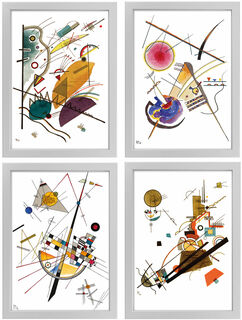Set of 4 pictures, framed


Set of 4 pictures, framed
Quick info
ars mundi Exclusive Edition | reproductions on Gmund Tactile | framed | glazed | size each 38.5 x 28 cm (h/w)
Detailed description
Set of 4 pictures, framed
The Berlin Secession exhibited his works, he was a member of the Neue Künstlervereinigung München and co-founder of the "Blaue Reiter" - Wassily Kandinsky contributed to many art revolutions of the early 20th century.
Around 1913, he finally parted with representationalism in painting and ultimately abandoned the art world of objects altogether. Instead, he concentrated on graphic elements, constructions and (colour) compositions. "Ten looks at the canvas, one at the palette, and half a look at nature" is how he described his working method, which he theoretically underpinned in his famous Bauhaus writing "Point and Line to Plane" in 1926.
Four lavish reproductions on hand-made, heavy 250g Gmund Tactile, framed in silver-coloured solid wood frame, glazed. Size 38.5 x 28 cm (h/w) each. ars mundi Exclusive Edition.
"Composition": Original: 1923, watercolour and ink on paper, 36.5 x 25.3 cm (h/w), Kunstmuseum Kupferstichkabinett, Basel.
"Composition": Original: 1925, watercolour.
"Delicate Tension": Original: 1923, watercolour and ink on paper, 35.5 x 25 cm (h/w), Museo Nacional Thyssen-Bornemisza, Madrid.
"Happy Ascent": Original: 1923, colour lithograph on wove paper, 23.8 x 19.3 cm (h/w), Bauhaus Archive, Berlin.
Set of all four works.
This set contains the following products
Customer reviews
Sehr zufrieden
Schnelle Lieferung, alles problemlos
Alles bestens, danke
Ganz toll. Wie erwartet: Bilder und Verpackung TOP !!! Und Lieferzeit voll in Ordnung!
Schnelle Lieferung, sehr gut verpackt.
PROMPTE Lieferung , saubere Rahmung

About Wassily Kandinsky
1866-1944, abstract expressionist, co-founder of the artists' group "Der Blaue Reiter".
Like no other, Kandinsky wrote the "alphabet of 20th-century art". Through his abstract painting, he was able to convey the original power of colour and composition without being distracted by the depiction of objects. In his view, the mystery of LIFE could only be captured and represented through the abstract collision of colour and graphic form.
Wassily Kandinsky was born in Moscow in 1866 and died in Neuilly-sur-Seine, France in 1944. Despite his success as an economist and doctor of law he decided to pursue an artistic career and attend art school in Munich in 1896. In 1901, Kadinsky founded an art school called "Phalanx", where he met Gabriele Münter, who later became his companion during his years in Munich. Numerous journeys through Europe and to Tunis and the various impressions he gained while travelling shaped his pictorial expression. Gabriele Münter bought a house in Murnau in 1909, which allowed the couple to spend a longer period of time in the mountain town and Munich.
Kandinsky's early Munich paintings were influenced by Art Nouveau and Russian folk art, whose fairy-tale themes lingered in his works for a long time. The reverse glass paintings by the co-founder of the "Neue Künstlervereinigung München" of 1909 and the "Blaue Reiter" of 1911 reflect his impressions of the folk Bavarian art tradition.
During the First World War, the Russian returned to Moscow. Back in Germany in 1922, he played a decisive role working and teaching at the Bauhaus in Weimar and Dessau. In the end, however, Kandinsky was drawn to Paris where he remained until his death in 1944. From 1933, he lived in the metropolis on the Seine with his wife, whom he had married in Russia.
His encounter with the Russian Constructivists left its mark on Kandinsky's work which can be seen in the geometrisation and lines that are in dynamic tension with each other. In his theoretical writings on art, he expounded the fundamental theory of harmony in abstract art.
The viewer not only discovers the close connection between music and painting through his paintings, but it is also underlined by the composer Kandinsky: "Color is the keyboard, the eyes are the harmonies, the soul is the piano with many strings. The artist is the hand that plays, touching one key or another, to cause vibrations in the soul..."
Term for paintings and sculptures that are detached from the representational depiction, which spread throughout the entire western and parts of the eastern world from around 1910 onwards in ever new stylistic variations. The Russian painter Wassily Kandinsky, born in 1866, is considered the founder of abstract art. Other important artists of abstract art are K.S. Malewitsch, Piet Mondrian, and others.
Graphic or sculpture edition that was initiated by ars mundi and is available only at ars mundi or at distribution partners licensed by ars mundi.
Artistic movement that replaced Impressionism in the early 20th century.
Expressionism is the German form of the art revolution in painting, graphic art and sculpture, which found its precursor in the works of Paul Cézanne, Vincent van Gogh and Paul Gauguin in the late 19th century. The Expressionists attempted to advance to the primal elements of painting. With vibrant, unbroken colours in large areas and with the emphasis on the line and the resulting targeted suggestive expressiveness, they fought against the artistic taste established by the bourgeoisie.
The most important representatives of Expressionism were the founders of "Die Brücke" (The Bridge): Ernst Ludwig Kirchner, Erich Heckel, Karl Schmidt-Rottluff, Max Pechstein, Otto Mueller and Franz Marc, August Macke and others.
Masters of Viennese Expressionism are Egon Schiele and Oskar Kokoschka. Among the sculptors, Ernst Barlach is the most famous.
Fauvism is the French form of Expressionism.






